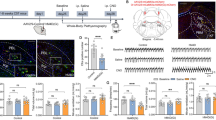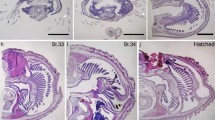Summary
-
1.
The dependence of electrogenic sodium pump activity on changes in the cell volume ofHelix pomatia neurons with different levels of intracellular sodium ion concentration was studied.
-
2.
Hypertonic solutions caused hyperpolarization of the membrane and increased membrane resistance in cells with a low sodium content (low-sodium cells; LSC).
-
3.
The activity of the electrogenic sodium pump in hypertonic solutions was increased compared to the activity in hypotonic solutions in LSC and decreased in cells with a high sodium content (high-sodium cells; HSC).
-
4.
The concentration of ouabain which led to maximal inhibition of active22Na efflux from the neurons was 10−4 M. Lower concentrations of ouabain (10−8 M and lower) did not inhibit the sodium pump but stimulated it.
-
5.
The swelling of neurons in hypotonic solutions was accompanied by an increase in the number of binding sites for ouabain, while shrinking in hypertonic solutions led to the opposite effect—a decrease in binding sites. An increase in the number of binding sites also took place in normal isotonic potassium-free solutions compared with normal Ringer's solution. Two saturable components of ouabain binding were detectable in all solutions examined.
-
6.
γ-Aminobutyric acid (GABA) and acetylcholine (ACh) increased the number of ouabain binding sites on the membrane.
-
7.
The results suggest that there are two opposite mechanisms by which cell volume changes can modulate the pump activity. One of them depends on the intracellular sodium ion concentration and causes pump activation in hypertonic solutions in LSC and saturation in HSC, while a second mechanism mediates the activating effect of cell swelling on the sodium pump in HSC. In addition, there may be a negative feedback between the pump activity and the number of functioning pump units in the membrane.
Similar content being viewed by others
References
Ayrapetyan, S. N., and Arvanov, V. L. (1979). On the mechanism of the electrogenic sodium pump dependence of membrane chemosensitivity.Comp. Biochem. Physiol. 64A601–604.
Ayrapetyan, S. N., and Suleymanyan, M. A. (1979). On the pump-induced cell volume changes.Comp. Biochem. Physiol. 64A571–575.
Baker, P. F., and Willis, J. S. (1970). Potassium ions and the binding of cardiac glycosides to mammalian cells.Nature 226521–523.
Baker, P. F., and Willis, J. S. (1972). Binding of cardiac glycoside ouabain to intact cells.J. Physiol. (Lond.) 224441–462.
Frankenhaeuser, B., and Moore, L. F. (1963). The specifity of the initial current in myelinated nerve fibers of Xenopus laevis., voltage clamp experimentals.J. Physiol. (Lond.) 163438–444.
Gage, P. W., and Quastel, D. M. J. (1966). Competition between sodium and calcium ions in transmitter release at mammalian neuromuscular junctions.J. Physiol. (Lond.) 18595–123.
Godfraind, T., and Ghysel-Burton, J. (1977). Binding sites related to ouabain-induced stimulation or inhibition of the sodium pump.Nature 265165–166.
Kernan, R. P. (1962). Membrane potential changes during sodium transport in frog sartorius muscle.Nature 193986–987.
Keynes, R. D. (1965). Energy transformations in the generation of bioelectricity. InControl of Energy Metabolism (Chance, B., Estabrook, R. W., and Williamson, J. R., Eds.), Academic Press, New York, pp. 375–381.
Kostyuk, P. G., Krishtal, O. A., and Pidoplichko, V. I. (1972). Potential-dependent membrane current during the active transport of ions in snail neurones.J. Physiol. (Lond.) 226373–392.
Moore, J. W. (1959). Electronic control of some active bioelectric membranes.Proc. IREE 471869.
Mullins, L. J., and Awad, M. Z. (1965). The control of the membrane potential of muscle fibers by the sodium pump.J. Gen. Physiol. 48761–775.
Tomita, T. (1966). Electrical responses of smooth muscle to external stimulation in hypertonic solution.J. Physiol. (Lond.) 183450–468.
Venosa, R. A. (1978). Stimulation of the Na+-pump by hypotonic solutions in skeletal muscle.Biochim. Biophys. Acta 510378–383.
Wheal, H. V., Horn, N. M., and Austin, G. M. (1977). The effect of sodium pump inhibitors onAplysia neuronal cell volume.Comp. Biochem. Physiol. 57C139–141.
Author information
Authors and Affiliations
Rights and permissions
About this article
Cite this article
Ayrapetyan, S.N., Suleymanyan, M.A., Saghyan, A.A. et al. Autoregulation of the electrogenic sodium pump. Cell Mol Neurobiol 4, 367–383 (1984). https://doi.org/10.1007/BF00733598
Received:
Revised:
Accepted:
Issue Date:
DOI: https://doi.org/10.1007/BF00733598




